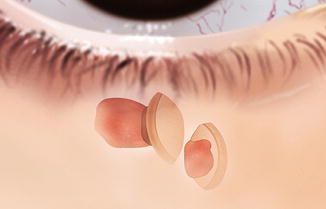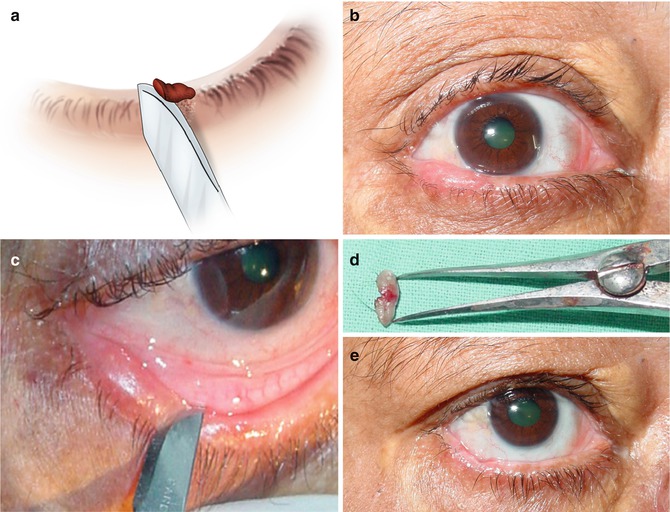(1)
Alo Eye Care, Kolkata, India
Keywords
BiopsyIncisional biopsyShave excisionPunch biopsyExcisional biopsyFrozen sectionMohs micrographic surgery10.1 Introduction
All cases of suspected lid tumors should undergo biopsy and histopathologic confirmation. The type of biopsy depends on the clinical evaluation of the lid mass and may range from a simple incision biopsy to a complex frozen section and Mohs micrographic surgery (MMS). In this chapter, we discuss the different biopsy techniques and their indication.
10.2 Incisional Biopsy
10.2.1 Introduction
A biopsy is considered incisional when only a portion of the lesion is removed.
10.2.2 Indication
Incisional biopsy is indicated when a lid lesion has not responded to medical management and the character of the lesion is unknown. It also is used when malignancy is suspected but it cannot be determined whether surgical removal of the lid lesion is indicated. In these cases, this technique is used to confirm the suspicion so that a complete second-step radical surgery may be planned. A classic indication is a case in which basal cell carcinoma is suspected. If a lid lesion clinically looks malignant, frozen section and reconstruction are preferred over incisional biopsy.
10.2.3 Surgical Technique
A local anesthetic agent with adrenalin is injected or infiltrated around the suspected tissue. A section of the tissue is grasped carefully with forceps, and a small piece of the lid tumor is removed with a scalpel blade. Punch forceps or scissors also may be used to excise a small piece of tissue. Ideally, the sample should be taken from the margin of the mucocutaneous junction. The central portion should be avoided, especially in ulcerated lesions, because histopathology may reveal only necrotic tissue and therefore will be inconclusive. If the quantity of tissue taken is not adequate, one should not hesitate to remove more. The success of the biopsy is of utmost importance for determining further treatment and management.


Fig. 10.1
Incisional biopsy
10.3 Shave Biopsy
10.3.1 Introduction
In shave biopsy, a technique used in cases of a suspected nevus or growth on the lid margin, the pathologic tissue is removed flush from the lid margin with a scalpel blade. The aim is to confirm the pathology of the lesion. This technique is used to confirm the character of the lesion on histopathology so the appropriate treatment can be planned.
10.3.2 Indication
Shave biopsy is indicated for a suspected nevus or growth on the lid margin when one is in doubt whether it is malignant or benign. The aim is not to remove the tumor, but rather to clinch a clinico-histopathological diagnosis.
10.3.3 Surgical Technique
The surrounding tissue is infiltrated, or a regional block is given. The growth is pulled with a small tooth forceps, away from the lid margin. A Bard-Parker no. 15 blade is used to shave the elevated mass from the lid margin. After the specimen is marked appropriately, it is sent for histopathologic evaluation. The slight oozing from the base usually can be stopped by applying a bit of pressure. If bleeding persists, cautery may need to be done at the base.


Fig. 10.2
Shave biopsy. (a) A Bard-Parker no. 15 blade is used to shave the elevated mass from the lid margin. (b) A lid margin soft tissue mass. (c) Shave excision. (d) Excised tissue. (e) First day post shave excision
10.4 Punch Biopsy
10.4.1 Introduction
Punch biopsy is quite similar to incisional biopsy; the major difference lies in the use of a punch to take the specimen.
10.4.2 Indication
Punch biopsy is very useful for the diagnosis and confirmation of pigmented lesions suspected of being malignant, especially melanoma. This technique is especially indicated for lesions lying in the periorbital region and not involving the lid margin. This method is particularly helpful in assessing the depth of a lesion.
Stay updated, free articles. Join our Telegram channel

Full access? Get Clinical Tree


